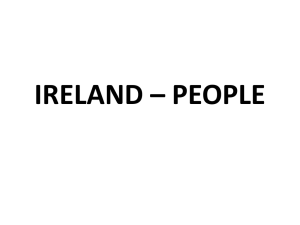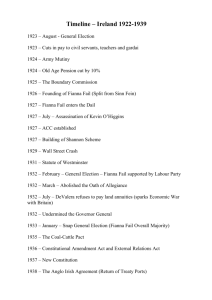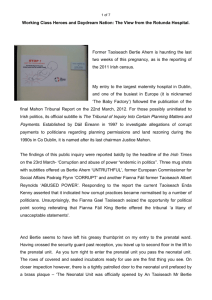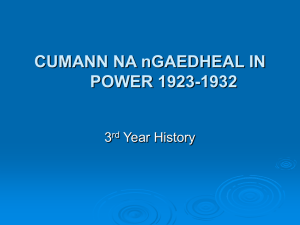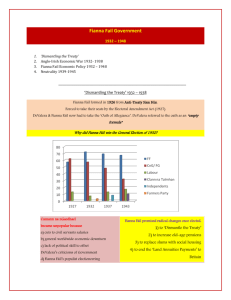The Irish Dáil Election 2007 JANE SUITER
advertisement
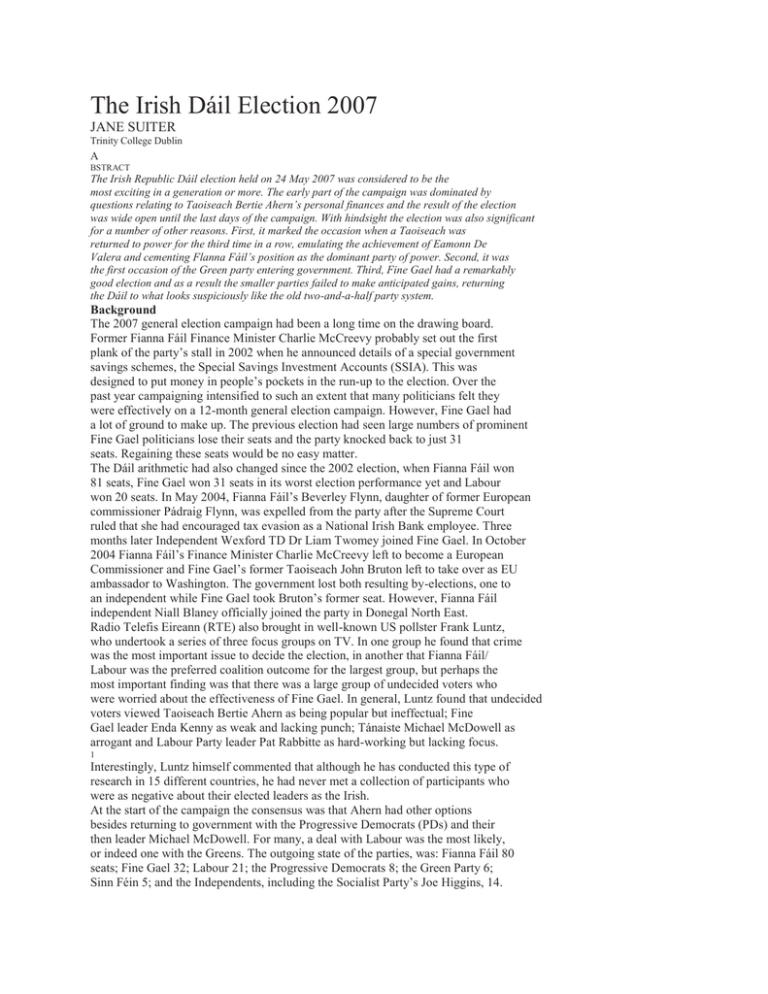
The Irish Dáil Election 2007 JANE SUITER Trinity College Dublin TF1I0O2T210JSra07030IuairnPs.90yiyi1hgetS080le0S oio-0_rPn8ur7j0Aao @0i1a&Fltl_/ 8nei0eAt t2r4dcFib77crd r9(Fta6.auip0ilrc7naer a7lS9icrenn1yit3csut8 .)2isd0/s0g1i7 eL0m70s8t41d37-698007289 (online) A BSTRACT The Irish Republic Dáil election held on 24 May 2007 was considered to be the most exciting in a generation or more. The early part of the campaign was dominated by questions relating to Taoiseach Bertie Ahern’s personal finances and the result of the election was wide open until the last days of the campaign. With hindsight the election was also significant for a number of other reasons. First, it marked the occasion when a Taoiseach was returned to power for the third time in a row, emulating the achievement of Eamonn De Valera and cementing Flanna Fáil’s position as the dominant party of power. Second, it was the first occasion of the Green party entering government. Third, Fine Gael had a remarkably good election and as a result the smaller parties failed to make anticipated gains, returning the Dáil to what looks suspiciously like the old two-and-a-half party system. Background The 2007 general election campaign had been a long time on the drawing board. Former Fianna Fáil Finance Minister Charlie McCreevy probably set out the first plank of the party’s stall in 2002 when he announced details of a special government savings schemes, the Special Savings Investment Accounts (SSIA). This was designed to put money in people’s pockets in the run-up to the election. Over the past year campaigning intensified to such an extent that many politicians felt they were effectively on a 12-month general election campaign. However, Fine Gael had a lot of ground to make up. The previous election had seen large numbers of prominent Fine Gael politicians lose their seats and the party knocked back to just 31 seats. Regaining these seats would be no easy matter. The Dáil arithmetic had also changed since the 2002 election, when Fianna Fáil won 81 seats, Fine Gael won 31 seats in its worst election performance yet and Labour won 20 seats. In May 2004, Fianna Fáil’s Beverley Flynn, daughter of former European commissioner Pádraig Flynn, was expelled from the party after the Supreme Court ruled that she had encouraged tax evasion as a National Irish Bank employee. Three months later Independent Wexford TD Dr Liam Twomey joined Fine Gael. In October 2004 Fianna Fáil’s Finance Minister Charlie McCreevy left to become a European Commissioner and Fine Gael’s former Taoiseach John Bruton left to take over as EU ambassador to Washington. The government lost both resulting by-elections, one to an independent while Fine Gael took Bruton’s former seat. However, Fianna Fáil independent Niall Blaney officially joined the party in Donegal North East. Radio Telefis Eireann (RTE) also brought in well-known US pollster Frank Luntz, who undertook a series of three focus groups on TV. In one group he found that crime was the most important issue to decide the election, in another that Fianna Fáil/ Labour was the preferred coalition outcome for the largest group, but perhaps the most important finding was that there was a large group of undecided voters who were worried about the effectiveness of Fine Gael. In general, Luntz found that undecided voters viewed Taoiseach Bertie Ahern as being popular but ineffectual; Fine Gael leader Enda Kenny as weak and lacking punch; Tánaiste Michael McDowell as arrogant and Labour Party leader Pat Rabbitte as hard-working but lacking focus. 1 Interestingly, Luntz himself commented that although he has conducted this type of research in 15 different countries, he had never met a collection of participants who were as negative about their elected leaders as the Irish. At the start of the campaign the consensus was that Ahern had other options besides returning to government with the Progressive Democrats (PDs) and their then leader Michael McDowell. For many, a deal with Labour was the most likely, or indeed one with the Greens. The outgoing state of the parties, was: Fianna Fáil 80 seats; Fine Gael 32; Labour 21; the Progressive Democrats 8; the Green Party 6; Sinn Féin 5; and the Independents, including the Socialist Party’s Joe Higgins, 14. An Irish Examiner/Lansdowne poll in September 2006 provided a snapshot of opinion just after Michael McDowell took over as leader of the Progressive Democrats. It showed a relatively stable pattern from a year earlier. 2 Fianna Fáil and the PDs could claim 45 per cent of the votes, while Fine Gael and Labour could draw on the allegiance of a combined 34 per cent of the electorate; the Greens had the support of 6 per cent, while Sinn Féin stood at 9 per cent, and the independents at 6 per cent. In early 2004, in conjunction with The Sunday Business Post , RED C introduced an innovative approach to political polling in Ireland, interviewing people by telephone rather than face to face. As the chart below (Figure 1) demonstrates, support for Fianna Fáil fell off quickly after the 2002 election to a low of 32 per cent by September 2005. It then moved in a range between 35 per cent and 38 per cent until a spike in January 2007 when it peaked at 42 per cent, a level to which it would not return until the election. Other polling companies had similar findings. By the beginning of the campaign things had moved little Fianna Fáil were still on 38 per cent, according to a poll by Millward Brown IMS. Fine Gael were on 23 per cent, followed by the Labour Party with 12 per cent, Sinn Féin with 8 per cent, the Green Party with 6 per cent, and the Progressive Democrats with 4 per cent. Figure 1. Monthly RED C Polls, September 2005–June 2007 Source : Red C The Campaign The campaign began in most unusual fashion. In the early hours of Sunday morning on 29 April 2007 Ahern made an unprecedented dawn run to Aras an Uachtarain to seek the dissolution of the Dáil from President Mary McAleese. The move, which followed a round of midnight phone calls to the papers to inform them he would be going to the President the following day meant that most the papers were too late to have much coverage. The exception was The Sunday Independent, which Ahern had told of his move on the Saturday morning. That paper had, just a few weeks before, changed tack to support Ahern. The manoeuvre backfired as The Irish Times headline on the first full day of the campaign of 30 April put it: ‘Fianna Fáil’s early start gives impression they’re on the run’. Journalist Miriam Lord wrote: ‘It just looked wrong. No matter what way they spin it in the coming days, yesterday morning was a disaster for Fianna Fáil.’ The move was compounded by Ahern’s refusal later in the day to take any questions at a press conference. The strategy stood in marked contrast to the 2002 campaign when veteran Fianna Fáil director of elections PJ Mara declared, ‘It’s Showtime’ at the opening press conference of that campaign. 3 Indeed it was most likely revelations in The Sunday Tribune that caused the walkout at the press conference. The newspapers had been focusing on ongoing revelations about Ahern’s finances when as Minister for Finance in the early 1990s he had benefited from a series of unexplained and unreported donations from friends. Ahern had answered some questions the previous autumn in an RTE interview with Bryan Dobson, but as the election was called further contradictory details had emerged including a question about money given to him and his partner Celia Larkin by his then landlord, Chris Wall. At the same the time the long established Mahon Tribunal which was examining planning irregularities and payments to politicians was about to start its so-called Quarryvale module. That module directly affected Ahern and both he and his former partner were due to be called as witnesses. The Tribunal decided to postpone the controversial Quarryvale hearings until after the election but nonetheless a transcript with details of Ahern’s bank records was leaked to the public. These events conspired to keep the issue of Ahern’s finances at the top of the agenda, although the party did make an attempt to regain the initiative by focusing on the economy at daily press conferences. 4 Figure 3 about here Despite these efforts the issue of Ahern’s finances overshadowed even the launch of the Fianna Fáil manifesto. Veteran journalist Vincent Browne launched an astonishing attack on the Taoiseach. Lasting 12 minutes (amid interruptions from director of elections PJ Mara), Browne questioned why Ahern did not tell Bryan Dobson in a clear-the-air interview last year that Michael Wall called to his office in 1994 and gave him a briefcase containing £30,000 sterling in cash three days before he expected to become Taoiseach. At the time, Mr Wall was renting a house to Bertie Ahern and his then partner Celia Larkin. By Saturday night Charlie Bird was reporting on RTE that Tánaiste and PD leader Michael McDowell was threatening to jump ship, leading to a meeting of senior Fianna Fáil ministers on the Sunday who decided that Ahern would have to meet the issue head on. As Stephen Collins wrote the following week (Irish Times, 9 June): By initially backing Ahern when the controversy broke, then threatening to pull out of Government, subsequently modifying that stance and insisting on a statement, and finally coming across as great pals with the Taoiseach at the Arbour Hill commemoration last Wednesday, McDowell has created utter confusion about his position. With the PDs already up against it the effect may be disastrous. In contrast to Ahern and McDowell, Fine Gael leader Enda Kenny had an upbeat start to his campaign. Warning opponents that they would need to take him seriously he kicked off his presidential-style election tour by publicly signing his Contract for a Better Ireland. Fine Gael had also learned the lessons of the last campaign when Ahern appeared nightly on the news bulletins glad-handing voters all over the country and spurning traditional press conferences in favour of open air events. The Irish Times headline of 3 May provides a taste of the coverage: ‘All-action Hurricane Enda takes country by storm.’ He also focused relentlessly on what focus groups had determined as core issues of health and crime. Kenny’s performance buoyed the party, with many believing that it had a real chance of taking power for the first time since 1982. Fine Gael’s putative partner, the Labour Party, confidently set out its stall also believing that public services would decide the election. Labour was focusing on a few key messages to voters: a PAYE standard rate tax cut; no extra taxes elsewhere; better public services; more gardaí; cheaper housing for young people. With the issue of climate change moving up the agenda in the run-up to the election, there was a widespread belief that the Greens could do well. The party started the campaign well with an impressive and widely acclaimed economic policy document. However, the party’s candidates often appeared uncomfortable with actual campaigning. Sargent was also determined to keep his coalition options open although he did state a preference for a coalition with Fine Gael and Labour. He also stated that he personally would not lead the Greens into a coalition with Fianna Fáil but that under those circumstances he would serve as a cabinet minister. The danger for the Greens was that by keeping coalition options open they would be squeezed by a resurgent Fine Gael. Sinn Féin was also in optimistic mood at the start of the campaign. The party was still being ruled out as a possible coalition partner by all the other main parties but the breakthrough in the North was assumed to be of help. The second week of the campaign began much as the second one ended. This was, as The Irish Times reported, to be the ‘statesman week’, with the Northern Ireland Executive being formed and the symbolic visit of First Minister, Dr Paisley, and the Taoiseach to the site of the Battle of the Boyne. The payments issues remained alive, but eventually Fianna Fáil forced the agenda onto the issue of who had provided the leaks, Kenny being forced into strongly denying claims that Fine Gael had leaked information from the Mahon tribunal. Ahern’s historic speech to the Houses of Westminster received widespread acclaim. By the mid-point of the campaign the election still appeared to be on a knifeedge, but Fianna Fáil had got itself on to an even keel and morale among party workers had improved considerably. As the contest entered the third week all attention was on the long-awaited television debate between the alternative Taoisigh, Ahern and Kenny. Another programme involving the leaders of the smaller parties preceded the main debate. As expected McDowell put in a robust performance, describing the other leaders as ‘the left, the hard left and the leftovers’. But perhaps the most notable aspect of the debate was the very poor showing by Gerry Adams, who was widely regarded as being out of touch and lacking knowledge of economic policies important to the electorate in the Republic. In advance of the main debate the following night, Fianna Fáil strategists were confident that Bertie Ahern would win comfortably. After all he had been in the job for ten years and had a mastery of the detail of policy. Of course, winning the debate is not enough. In 1997 the then Fine Gael Taoiseach John Bruton was widely regarded as having won the debate but he did not win the subsequent election. His successor Michael Noonan had also done well in his debate with Ahern without reaping any obvious reward. In the event, according to The Irish Times, Kenny scored on confidence and Ahern on detail. Others gave the debate to Ahern but all were surprised at how well Kenny comported himself. As The Independent put it: ‘Ahern shades it but fails to land knockout.’ Later polls however, gave the debate to Ahern. Red C found that the most influential event on voter behaviour appears to have been the televised leaders’ debate, which had an impact on voting behaviour of a third of all who voted. More importantly, it found it influenced more than half of those who ended up voting for Fianna Fáil. This suggests Bertie Ahern won the debate by a long way among floating voters. The Polls Opinion polls also played a large part on the campaign. Going into the penultimate week the opposition were buoyant. The Sunday Business Post Red C Poll on 13 May showed that Fine Gael had continued to make significant gains in political support since the previous week. At the same time Fianna Fáil had fallen two points to 35 per cent, leaving that party facing a significant loss of Dáil seats. The results were repeated a couple of days later when a Millward Brown IMS poll for The Independent (14 May) led that paper to claim that Fianna Fáil was in a ‘nose dive’ and Ahern was facing a 20-seat loss. The poll also found that a Fine Gael–Labour coalition was becoming increasingly popular as a preferred government after the election. These findings appear to have prompted Deputy Fianna Fáil leader and Finance Minister Brian Cowen into action. At his daily press conference the Minister wrested control of the campaign back from its ongoing focus on Ahern’s finances and Kenny’s good showing. In typical fighting mode he and his adviser Colin Hunt relentlessly focused on Fine Gael and Labour commitments on health and crime, and questioned the basis of opposition figures about hospital beds and extra gardaí. Up to this point, the smaller parties had made little impact, being increasingly swallowed up by the presidential nature of the campaign. McDowell decided to fight back and in an attempted repeat of his infamous stunt at the previous election he mounted a lamppost in his hometown of Ranelagh. In 2002 he had unveiled a poster saying ‘One Party Government? – No Thanks!’ It was widely, though unjustifiably, credited at the time for turning around the fortunes of the PDs at that election. This time the slogan was ‘Left Wing Government? – No Thanks!’ But as The Independent subsequently noted, the lamppost stunt flopped as the Greens showed up. Green party president and McDowell’s constituency rival John Gormley had gone wind of the stunt and showed up waving a booklet and admonishing McDowell for attempted intimidation and lies. In the meantime Fianna Fáil’s fortunes took a turn for the better and the party began to rise once again in the polls. The weekend polls showed a resurgence for Fianna Fáil, and on the Monday before the election The Irish Timespublished a poll which put the speculation almost beyond doubt, showing a major resurgence for the party. Support for Fianna Fáil was up by five percentage points to 41 per cent while support for Fine Gael was down one point and Labour down three points. The government parties thus had a lead of six points over the alternative alliance with less than a week of the campaign to go. There was also a change in the perception about who would win the election, with a four-point lead for the Fianna Fáil–PD coalition compared to a one-point lead for the Fine Gael-led alternative in the previous poll. On many days the polls provided the main news of the campaign day itself and they also served to motivate campaign teams. In general the quality of the polls carried out in the Republic is fairly good. However, they are subject to the usual qualifications, some to a greater extent than others. Nevertheless, as Table 1 shows, the national polls undertaken by the different organisations are remarkably consistent. Most of polls were within the margin of error and did not justify the headlines with which the media described their findings. The exception, however, was the TNS/ MRBI poll on the Monday before the election for The Irish Times, which was spot on in its numbers for the three larger parties and well within the margin of error for the smaller parties. This was also the only poll in advance of election day that had Fianna Fáil support at over 40 per cent. So how did Fianna Fáil increase its support coming into the last weekend? Many commentators believe that Fianna Fáil’s offensive, led by Cowen, stressing the ‘big gamble with their jobs and homes that the novice’, Enda Kenny, constituted for voters. The same TNS/MRBI poll that predicted the Fianna Fáil resurgence may also cast some light. When voters were asked which of the alternative coalitions they would like to see forming the next government, the Fianna Fáil–PD coalition had moved into a six-point lead over the Fine Gael–Labour alliance, with the possible support of the Greens. On the issue of the Taoiseach’s finances, when asked if it was a serious issue in the election campaign, 36 per cent said it was but 54 per cent said it was not. The poll also showed a four-point increase in Mr Ahern’s satisfaction rating to 58 per cent. It is likely that the findings are the results of a renewed focus on the competence of party leaders with the leaders’ debate proving a crucial focus for this. In this regard it is also likely that Cowen’s hard work in undermining the credibility of the opposition on the economy did its work. Table 1. Poll Results 2002–2007 Poll data FF FG Lab SF PD Gp Ind 2002 general 41.5 22.5 11 6.5 4 4 11 2004 local 31.5 28 12 8 4 4 14 IMS 16–17 April 38 23 12 8 4 6 8 Red C 16–18 April 36 27 11 10 3 9 7 MRBI 23–24 April 34 31 10 10 3 6 6 IMS 2–3 May 37 26 12 9 2 6 8 RED C 2–3 May 37 26 12 9 2 6 8 MRBI 8–9 May 36 28 13 10 2 8 6 Red C 9–10 May 35 29 12 7 3 6 8 IMS 9–10 May 35 26 13 10 3 5 8 IMS 16–17 May 37 25 12 9 3 5 9 Red C 16–18 May 36 27 11 10 2 8 6 MRBI 18–19 May 41 27 10 9 2 6 5 Red C 21–22 May 38 26 11 9 3 6 7 Lansdowne exit 41.5 26 10 7 3 5 7 Result 41.5 27 10 7 3 5 7 Winners and Losers As noted above, the RTE exit poll provided an excellent call for the results and was very close to the final outcome. As the first tallies began in counting centres across the country it quickly became obvious that Fianna Fáil was holding up well, as was Fine Gael. Quite apart from the national considerations outlined above, local factors and party organisation also played a part. In several constituencies in Dublin Fianna Fáil was in danger of splitting its vote for the second or third seat. Resources were poured into constituencies where seats were considered under threat and a big push was made to promote candidates in the local media. In the Taoiseach’s own constituency of Dublin Central, for example, there was some controversy when Ahern authorised an eve-of-poll leaflet drop asking his supporters to give their number two to his constituency organiser Cyprian Brady rather than Mary Fitzpatrick, the daughter of his retired running mate. In the event Brady won a seat with just 939 first preferences. Fine Gael also had an impressive election, with the party gaining some 20 seats (see Table 2). As always there was drama in counting centres. In Dublin’s Royal Dublin Society (RDS) it quickly became apparent that McDowell and Gormley would have a long contest, as they had done in 1997. In the end it came down to just 300 transfers too few from Fianna Fáil’s Jim O’Callaghan to McDowell, and Gormley prevailed (again!). At the same time McDowell’s party colleagues were doing badly across the board. Party president Tom Parlon lost his seat in Laois Offaly while deputy leaders Liz O’Donnell lost her seat in Dublin South, as did Fiona O’Malley in Dun Laoghaire. In the event only former leader and Minister for Health Mary Harney and Noel Grealish in Galway West held back the tide. More surprising was the relatively poor performance of the Greens and Sinn Féin, at least given the expectations that had mounted up about their likely performance. Conversely Fianna Fáil’s performance was considered good even though the party lost three seats, given that expectations had risen that a disaster could be on the cards. Both smaller parties had been predicted to do well buoyed by the emergence of climate change as a serious issue and of the power-sharing agreement in Northern Ireland. The Greens suffered the Table 2. General election results 2007 (change since 2002) Party Votes no % Change vote share % Seats no Change seat share Fianna Fáil 838,593 41.56 0.08 78 − 3 Fine Gael 564,438 27.32 4.84 51 +20 Labour 209,175 10.13 − 0.65 20 − 1 PD 56,396 2.73 − 1.23 2 − 6 Green 96,936 4.69 0.85 6 0 Sinn Féin 143,410 6.94 0.43 4 − 1 Ind/Other 136,912 6.63 − 4.31 5 − 9 loss of front-bench spokesman Dan Boyle with the election of Mary White in Carlow Kilkenny keeping the numbers constant. Sinn Fein’s Mary Lou McDonald failed to win the seat most had predicted in Dublin Central, while Pearse Doherty, once its strongest tip, failed to win in Donegal South West. The party also lost one of its five outgoing deputies, Sean Crowe from Dublin South West, who had topped the poll in 2002. If the Greens’ disappointing performance was down to a resurgent Fine Gael then Sinn Féin’s was due to a strong performance by Fianna Fáil. Of course this is only supposition, although it is backed up by a look at the transfers picked up by the RTE/Landsdowne exit poll. The Greens picked up most of their transfers from Fine Gael and Labour while Fianna Fáil voters were more likely to transfer to Sinn Féin than to any other party apart from the PDs (see Table 3). More detailed work will be needed to support this, perhaps by using data from the Irish Election Study. Of course it was not only the Greens and Sinn Féin that did badly. Many independents also lost their seats and their overall share of the vote fell to 7 per cent from 11 per cent in 2002. This is partly due to the numbers seeking re-election. Two had moved into parties, Dr Liam Twomey to Fine Gael and Niall Blaney to Fianna Fáil, while two others did not run. Nevertheless their vote was down, perhaps partly because they had failed to deliver in the previous Dáil. The result was that of the 12 outgoing independents only half were returned. Although not technically an independent, one of the high-profile candidates who lost their seats was the Socialist party’s Joe Higgins, who was the victim, he believes, of under-representation in Dublin West, which only had three seats. Dr Jerry Crowley, a Mayo Independent, also lost out to an outstanding performance by Kenny in his home constituency, where the party gained three out of five seats. Fellow Mayo independent Beverley Cooper Flynn held onto her seat. Other health independents, Paudge Connolly in Cavan Monaghan and James Breen in Clare, also lost their seats. Former Fine Gael Minister Michael Lowry, however, won in Tipperary, as did Jackie Healy Rae in Kerry South, Tony Gregory in Dublin Central and Finian McGrath in Dublin North Central. The Labour Party also failed to deliver the gains it hoped would emanate from joining forces with Fine Gael. It saw its share of the vote drop slightly from 2002. It too argued that it was squeezed in the alliance with Fine Gael. But questions were also asked about the huge emphasis placed on the health services and crime. The voters may have said they were most worried about health but yet appeared to vote with their wallets. Marsh (2007; see also Garry et al., 2002) argues that issues in Irish elections tend to be those of competence. While there were differences in terms of election promises during the campaign, such as on tax rates, or pensions, and differences with respect to the means of addressing some issues – such as co-location as a means if addressing the shortage in hospital beds – in general the issue agenda in 2007 looked much as it did 2002. Transfers It is also instructive to look at where the transfers went. In its exit poll for RTE, Lansdowne Market Research asked which other parties the respondents voted for (see Table 2). In general it found that Labour and Fine Gael attracted the most transfers, a similar pattern to 2003. More Fianna Fáil voters transferred to Fine Gael or Labour than did not transfer at all. However, the question asked which other parties or candidates did the respondent vote for and did not ask specifically for a second preference. Coalition Formation The day after the election the then Green Party leader Sargent said his party would be willing to talk to Fianna Fáil. The strongest surviving independent Lowry also indicated that he would be willing to consider supporting a government led by Ahern. Ahern first lined up an unlikely group of independents including Lowry, McGrath and Healy Rae. None revealed details of spending commitments they had won for their own constituencies, leading to accusations of pork barrel politics at its worst. At the same time negotiations began with the Greens, with Fianna Fáil negotiator Seamus Brennan remarking to Gormley that he (Gormley) was now playing county hurling ‘[but] we are All Ireland finalists many times’. The negotiations would take ten days with the Greens walking out on the first weekend. Brennan later said he had thought the threat to walk had simply been a negotiating tactic. The Programme for Government was eventually agreed, but negotiations proved tough for the Greens and they emerged with little in the way of policy concessions, although they did win two powerful seats at the Cabinet table, even if both had areas of responsibility shaved off. Miriam Lord remarked in The Irish Times that with markedly few delivery dates set down in writing, the majority of the commitments could have been prefaced with the phrase: ‘In an ideal world …’ Without cast-iron agreements, those Table 3. Other parties/candidates voted for: transfers First preference Other preference given to 2002 2007 FF FG Lab Grn SF PD Ind/Other %%%%%%%%% FF 17 15 20 21 26 28 64 30 FG 21 20 23 49 38 18 34 25 Lab 26 26 20 43 42 27 22 23 Green 13 15 11 17 28 17 17 17 SF 9 10 12 8 15 15 9 10 PD 11 11 16 8 6 12 6 4 Ind/other 19 15 14 14 18 24 20 7 11 None 21 21 29 21 9 2 18 7 14 Source : Lansdowne Market Research Exit Poll Election 2007. become all too familiar to the coalition Greens when they start to deal with the Minister for Finance. But even as the Greens were in negotiations, Mary Harney of the PDs, Minister for Health in the outgoing government, was being kept informed of all events. One policy, which was not up for negotiation, was the co-location of hospitals, a controversial plan that Harney had done much to push through in the preceding Dáil. Her own position as Minister for Health was also unassailable. Even after securing the support of the Greens, the PDs and the three independents and thus ensuring his Dáil majority, Ahern threw a lifeline to Beverley Flynn who had had to leave the party after failing in a libel action against RTE. According to Stephen Collins in The Irish Times, it was a gesture of defiance, designed to show everybody, both inside and outside the party, just who is in charge. Conclusion The 30th Dáil convened on 10 June 2007 with Ahern leading in his ministers, including the two Green ministers John Gormley and Eamon Ryan. Ahern had returned with his reputation enhanced and Dáil arithmetic on his side. He has said he will not be contesting the next election, but will stay in power for five years. His decision to anoint Cowen as his probable successor means that the issue of the next leadership is likely to become a growing issue. The new ministries enhance the Greens, but theirs will be a tough battle and many will be watching carefully to see whether they can build their brand during their time in power and whether the ministers can enact their distinctive policies. The party’s future probably depends on this. Ahern’s other partner, the PDs, are in a rather different position. Almost all their major figures have left the party including even top leadership contender and party president Tom Parlon, who left to head up the Construction Industry Federation, and at the time of writing their very existence looked in doubt. The opposition parties are in a different situation. Many senior politicians are dismayed by the prospect of another five years on the opposition benches. However, Fine Gael had a good election, gaining 20 seats. Kenny’s leadership does not appear to be under threat and he has a good base from which to launch the next campaign. The presence of an influx of energetic young TDs will undoubtedly help. Labour, however, did not come back with extra seats and the party’s ageing leadership also makes the prospect of another long term in opposition difficult. As Rabbitte mused at the RDS on the night of the count, ‘I expect people were concerned about the fragilities of the economy’. It is also likely that Rabbitte’s sudden onset of coyness back in January about saying what Labour would do in a hung Dáil also came back to bite him. It was at odds with the strategy of building an alliance for an alternative government with Kenny and it left Labour isolated when the public mood ran in favour of Fine Gael as the only party that definitely would not put Fianna Fáil back in office. Sinn Féin has an even bigger problem; its failure to make a breakthrough came as a surprise to the leadership, which is used to winning elections. Its long-term strategy of being a significant party of power on both sides of the Border is now in tatters and Adams has come under fire particularly for two RTÉ television appearances where he appeared out of touch with reality and opinion in the Republic. Acknowledgements The author wishes to thank Michael Marsh for his helpful comments and suggestions. As ever all errors are mine. Notes 1. Election concerns, Irish Times , 5 December 2006. 2. Poll shows modest gains for government, Irish Examiner , September 2006. 3. FF floundering but can Kenny ride a rising tide?, The Irish Times , 5 May 2007. 4. Fianna Fáil’s U-turn, The Irish Times , 4 May 2007. 5. Showtime is more like a showdown as Bertie is Browned off, The Irish Times , 4 May 2007. 6. Has Bertie passed his sell by date?, The Irish Times , 11 July 2007. 7. Greens get on their bikes, but opt for low-key canvass, The Irish Times , 4 May 2007. 8. To the Joint Houses of Parliament, Westminster, 15 May 2007. Available at http://www.taoiseach. gov.ie/index.asp?locID=558&docID=3427. 9. Ahern’s performance proved the decisive factor, Sunday Business Post , 15 July 2007. 10. Polls are consistent but PR system always has last laugh, The Irish Times , 12 May 2007. 11. Major surge for Fianna Fáil as alternative loses support, The Irish Times , 21 May 2007. 12. Salad days over for Greens, it’s time to bite the bullet, The Irish Times , 14 June 2007. 13. Ahern now master of all he surveys, The Irish Times , 30 June 2007. 14. Back to the drawing board, The Irish Times , 14 July 2007. 15. Bertie tugs heartstrings and purse strings, The Irish Times , 26 May 2007. References Garry, J. (2002) ‘What decided the election?’ in M. Gallagher, P. Mitchell & M. Marsh (Eds) How Ireland Voted 2002, pp. 119–143 (London: Palgrave). Lansdowne Market Research Exit Poll (2007), available at http://www.lansdownemarketresearch.ie. Marsh, M. (2007) Candidates or parties: objects of electoral choice, Party Politics, 13(2), 500–527. Marsh M. (2008) ‘Explanations for Party Choice’, in M. Gallagher & M. Marsh (Eds) How Ireland Voted 2007, pp. 105–131 (Basingstoke: Palgrave). Jane Suiter is a Ph.D. candidate at the Department of Political Science, Trinity College Dublin, 2-3 College Green, Dublin 2, Republic of Ireland. Email address: Suiterj@tcd.ie
